Technical manual on the recovery of aluminum in artisanal developing countries C.de Gh.Bulteau Kerchove A. J. Divry Tchoufang G. Van den Bossche
Ingénieurs Assistance Internationale - Ingénieurs sans Frontières http://www.isf-iai.be mail@isf-iai.be Avenue du Marly 48, 1120 Brussels - Belgium

Collaborators
Were associated with the development of this guide and its correction:
- Gh. Bulteau (Fr), Engineer, Baudelet s.a., Technical Director of a aluminum refinery
- C.de Kerchove de DENTERGHEM, (B), I.C.Mét., Foundry of Lion s.a.
- A. Divry, Professor, Manager, of the foundry Divry Bertrand, aluminum foundry
- V.Gilard, (B), I.C.Ch., Ingénieurs sans Frontières
- L. Lepot, (B), President of the Group Foundry Wallonia-Brussels
- J. Tchoufang (Cam.), I.C.M.E., University of Liege
- G. Van den Bossche, ICMét., Ingénieurs sans Frontières, chief of Al. Project
Were involved in tests carried out in Belgium, France and Cameroon:
- V. Acha, (Cam) Engineer, Ingénieurs sans Frontières
- L. Bertrand, (B) Head of Workshop, Foundry Divry Bertrand
- Gh.Bulteau, (Fr) anc.professeur, Lycée Technique Armentières
- JMEtobe (Cam) University Engineer, Ingénieurs sans Frontières
- D. Ngantsengué (Cam), President of the Assaretra
- S. Pierre, Technician-founder, Assaretra
Introduction
Aluminum is a metal with a low melting point (~ 650 °C) which can be already made in relative simple installations and foundries where the bodies of machines, household objects and other decorative objects can be cast at a low production cost. In particular in many countries of sub-Saharan Africa, small artisanal foundries make objects by casting aluminum into molds in natural sand, also called <<à vert >>; sand is also very wet, in a very humid climate.

The manufacture of aluminum kitchen utensils by these <<à vert>> sand molding techniques is widespread in sub-Saharan Africa for several reasons:
- Production process is accessible without extensive personnel training or startup capital, nor significant operation funding for a company whose cash reserves are often inadequate and occasionally negative.
- Melting temperature is relatively low, hereby not requiring any complicated or expensive installation.
- Availability of raw materials, common and easy to acquire; often from scrap of which the collection is done by a labor force made up of jobless people.
- Secondary materials - simple refractory -basically clay- required for the manufacturing of the furnace and equipment, usually present in abundance, provided that onr satisfies himself with medium quality when compared to the same utensils made in stainless steel.
- Local manufacturing, close to the distribution channels which are the local outdoor markets.
- Low vending price and thus possible for a sale with often rural customers.
- Possibility of recovery of domestic waste production.
A number of artisanal foundries work from a cheap raw material collected from aluminum landfill and melt the scrap in a melting pot furnace.
A local reference: a foundry in Cameroon
The descriptive material contained in this document has been compiled primarily with help from a smalltime craftsman in Cameroon, Yaoundé from which we can say that:
- Its production can occasionally reach 400 kg/week of molten metal with charcoal as a fuel;
- The products consisted mainly of kitchen equipment, pots in all sizes, ladles, strainers ...
- The raw material used was aluminum-waste
- The merger was carried out in a melting pot furnace
- The area available for the production plant was reduced.
This artisan sought primarily to improve the quality of its products, which has been the reason for the intervention. The analysis of other information sources cited in the Appendices, as well as contacts with some experts in the industry, local and in Europe, have also helped to open up other coarses of action. It was possible to put in practice the principles studied during simulations in the workshop prior to local intervention. Methods and manuals listed below are not new, nor revolutionary. The approach is made of methods that were known and were used well before those of the era of space technology, but they have disappeared from workshops in the northern countries, due to profitability in an economic and social context which is theirs. On the other hand, one finds here and there, in sub-Saharan Africa for example, elements of appropriate technologies possible here. It was possible to apply them in a local context, such as with the local partner in Cameroon, while making improvements possible. These technologies must be able to help craftsmen of aluminum foundries to engage in this type of activity to improve the quality of its products and possibly be able to diversify his stock. The emphasis is on technologies limiting the supply of components or machinery or import products. And this by example for the manufacturing of:
- kitchen utensils,
- simple machine parts: wheels, pulleys, parts for farm equipment, ...
- decorative items such as medals, nameplates, ...
The site, building, premises
The site
In its simplest form, the production site will house the equipment and have following functions:
- Storage of raw material, aluminum recovery
- Storage of sand
- Fuel storage, in Cameroon usually charcoal
- Drying of sand in the sun
- Assembly of the wooden frame designated to contain the sand that will provide the footprint of the part to be fabricated
- Cleaning, reduction, sorting and storage of aluminum materials by category, separating at least the heavy pieces from the light ones, the heavy ones containing generally alloying elements in larger quantities, are more quickly melted than the light pieces and are melted first
- Realization of the sand mold
- Melting in a melting pot-type furnace
- Pouring into the molds
- Finishing with cutting, trimming and polishing tools
- Storage of unused frames, storage of raw materials such as secondary talc or wood ash, storage of tools.

The extent of the site and buildings is varies heavily depending on:
- the size of parts to manufacture and therefore the mold and the que to create
- availability of the workshop which may be only rented by day
- The storage possibilities
- rainfall and humidity in the location ...
Production sites seen in Cameroon

The workshop which was reviewed and to which reference was made in the introduction, is situated in Yaoundé, in the district of Tsinga, where the productive aluminum foundries are concentrated; it includes a building with the following characteristics: Land available ~ 130 m² Corrugated iron building structure Ground surface building 9x6m² Height ~ 3 m Sloping roof The building provides the storage of sand, furnace, mold manufacturing, the sand molds awaiting casting and store secondary materials. The smoke is blown out through the door and a few openings in the sidewalls. The site is leased to various smelters on a dayly basis. O: furnace o: hole in the event of the breaking of square melting pots: molds, local tools Here, we produce pots in dimensions of about 300mm diameter in quantities of approximately 100 pieces in a work day with a melting pot of a capacity close to 600 kg. Other small craftsmen from the same neighborhood have their furnace vented without a lid. This limits production to days without rain, in the dry season it obviously doesn't pose problems. In Douala, where the climate is much wetter than Yaoundé, in the New-Bell neighbourhood, the furnace is shielded with many craftsmen.
Improvements to implement in the workshop building
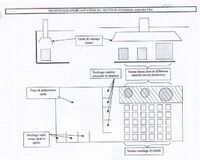
The main problems mentioned regarding the facilities are the following:
- Risk of explosion upon contact with melted metal and rain, if the furnace is not sheltered
- Exposure of staff to smoke
- Lack of space for storage and sorting of the raw material, it is brought on the day of production, the workshops do not belong to the smelters and are leased for the day.
- High risk of theft, especially as the workshops are concentrated in a single district outside of populated areas.
We can address the first two by placing the furnace in a more ventilated premise, separated by an enclosure, the furnace is not ultimately protected from rain than by a large canopy. The size of it, however, must consider the danger of explosion that may be created by contact of water with molten aluminum. A more expensive solution would be to have over the furnace:
- A hood with ventilation of the combustion fumes to the outside.
- A scheme incorporating the casting of the night, limits the risk of theft of raw material. A group of craftsmen allows rotating cooperative work, monitoring is exerted by the workmen not occupied by the melting work itself.
Appropriate process used
The process includes the following 7 operations:
- Gathering, cleaning, cutting and sorting of waste
- Drying of the sand
- Manufacturing of frames and molds
- Molding
- Fusion
- Casting
- Finish by trimming and polishing.
In Cameroon, the last operation, finishing, is traditionally done in other specialized workshops. Many small-scale foundries often do not occupy themselves in sorting and cleaning materials, or drying sand.
Gathering, cleaning and sorting of waste
Gathering: The basic raw material consists of scrap (waste) reclaimed from public landfill sites, or directly from users of aluminum, such as garages, for example, often in a state of unacceptable dirtyness. This scrap consist of a variety of objects. (In the appendix, we find an illustrative list.) Composition chemistry of the cast alloy is likely to be highly variable, depending on the manufacturing plant, and the melting temperature of the mixture.
Cleaning: Must be executed to the highest possible degree to avoid impurities and unnecessary takeup of pollutants:
- fats and oils and plastic parts which, in the casting, degrade by releasing toxic fumes
- the parts containing copper which, after melting, form a metal are best avoided for culinary applications: corrosion caused by water penetrates the walls and can release a hazardous copper oxide
- Metal items (screws, springs, rivets, ...)
Required installation: a free surface for manual removal of paints and other coatings of scrap parts, and plastic parts. Using a magnet which approaches the surface of the material placed on the soil, we may eliminate a number of steel parts, and we may avoid the inclusion of iron as well.
Sorting:
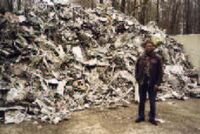
For the sake of fuel economy when merging, separating the large pieces such as housings, lighter engine parts, such as profilés, the latter being less likely to contain elements of alloys in large quantities, which would be otherwise molten as well at higher temperature. They will be enfournées in the melting pot, thereafter.
Installation requirements: a surface covered with a inclined sheet on which can be placed; downwards facing drain holes, containers and pieces containing oil. This sheet is inclined towards a chute collecting the oil and pouring it in a container.

Cutting of raw materials: We should primarily try to reduce the size of the scrap in order to introduce them in the melting process, by means of small machines. Facilities/tools needed:
- Shears, a simple machine, in appendix, suitable for profiles and plates
- Oxy-acetylene torch (garage type) for thick parts,
- Metal saws, hammer or weight
- Separate storage locations for the different categories of materials
first aluminum: the heavy, and light parts. Areas separated by walls of wood or concrete.

The treatment of the sand
The type of sand used
The sand must be a siliceous sand, ie with a very high percentage of silica. River sand is not sufficient. A <<à vert>> sand, with a composition approximatly as follows is suitable for the creation of the mold: Silica 80-90% Clay 8-15% Water 4%, (can be a little more, 6%, depending on the ambient temperature). The size of the sand affects the state of the part's surface: a fine sand provides a smooth surface. This size is generally characterized by an index called AFS. A value of 95 AFS provides an acceptable result locally (see Appenix 9). This sand is obtained either crude (containing clay), or by the mixture of highly silicieus sand which we enriches with clay in the form of bentonite, in order to obtain the proper composition. We can approximately determine the clay content of a natural silicious sand by the following test: Material:
- A transparent long and narrow glass, such as a small jar with screw lid, of 10-15 cm high
- Possibly a support to keep the container vertically.
Procedure:
- Fill up halfway with foundry sand
- Complete with water to fill the container entirely
- Shake well
- Let stand for one day: the silica settles gently on the bottom, itself topped by the clay, and topped with a layer of silt.
- Measure the height of the deposit below the silica.
- Comparing with the total height of the solid gives the percentage of silica in the sand.
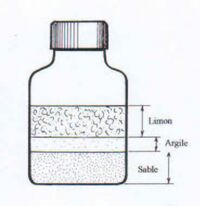
After each use, the sand must be allowed to pass again through the sieve to avoid lumps and possibly aluminum burrs which are accidentally present. To improve the surface of the skin of the piece, we can possibly provide for two qualities of sand. A finer sand in contact with the part and another one for coarser calibration and maintenance of the first. If the sand improves the surface condition of the piece, sand setting promotes the evacuation of gas by the micro-channels they burrow in the casting. The present coarse sand always exercises this function to facilitate the evacuation of gas. However, this technique requires more frequent renewal of the sand, because by its use, the two types are mixed. This reduces the ability of the calibration sand to evacuate the gas.
Drying, storing and sifting of the sand
Ideally, according to European criteria, the foundry sand should contain but 2 percent water, which is difficult to achieve in tropical climates. We must therefore use dry sand with H2O rates close to: 4% for clay content, with a maximum of 10% 6% for clay content, with a maximum of 15%
A simple device is used to measure it. On the other hand the weight of a quantity of sand before and after drying in a thin layer of 1cm max. near a furnace and sheet metal, can also infer with the moisture content. Drying sand for the molds can be done by exposure to sunlight through spreading it as a thin layer on a metal sheet during perhaps half an hour to 1 hour as follows:
- A floor space is covered with sheets of aluminum
- The sand is spread in a thin layer of 7 cm, prostrate to the sun and stirred up regularly to expose the lower layers which tend to absorb the moisture of the upper layers
- The storage of dry sand should be done out of reach of rain and humidity, in one or two tanks or closed tanks to enable easier rotation of their content and to maintain an acceptable moisture content, the water has the tendancy to drop to the bottom of the tank.
Apparent density of the sand pile: 1.6 - 1.7 Before each use, the sand will be sieved through a sieve with a mesh of about 1 mm.
Manufacturing of frames and molds

The frame is usually in steel or cast iron, and can be achieved more economically by wooden boards of a standard thickness of 12 mm assembled by nails. The dimensions of these frames are based on those of the molding piece, the position of the joint of the two half molds, the position of the attacks and casting channels. The height depends on the condition of the part to achieve. There must be a height least 150 mm above the highest point of the molding piece, so as to contain the thrust of the liquid metal at the end of the filling of the mold.
To facilitate removal, the boards at one of the 4 angles can be unified by a cord instead of nails, which can facilitate the demolding. Some theoretical basis for calculating the footprint of the piece: Linear shrinkage of the Aluminum: 1.2 to 1.4% Volumetric shrinkage: 8% by volume Remains: 3.5% These values must be confirmed by tests on a case by case basis.
Channels for the flow of molten aluminum is primarily inspired on following rules:
- Funnel-shaped cone slightly bent to avoid the whirling of the liquid and therefore the entering of air into the mold
- Descent with section Sd, decreasing from top to bottom
- Horizontal channel section with trapezoidal height = 2 times the width
- Attacks of thick plates of 2 or 3mm
- Vents in the upper part of the piece, in section Se with a total of Se=Sd for evacuating the gases contained within the imprint
Compliance ratios: Channel section/Descending section ≥ 1.2 Sum of attack sections/ Descending sections ≥ 2 In appendix, you will find complementary guide values.
Casting
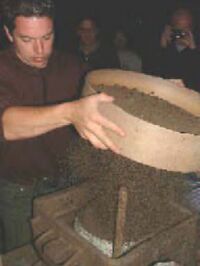
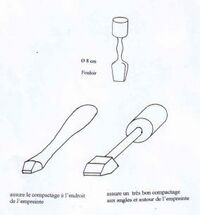
The preliminary operations: Sifting of sand on top of the frame through a sieve cloth with apertures of about 1 mm.
Adjustment of water content; classical test applied by the molder: "Take a handful of sand, strongly compress it in the hand, if the hand opens again, the sand will keep the design of the fingers distinctively, it contains enough water." Compaction using a rammer and then the foot, bearing the full weight of the body on the sand.
Ground molding for a drop cast by means of a single frame

This is the easiest method to create the mold. It is practiced particularly in India, Egypt and sub-Saharan Africa (Cameroon, Benin, ...). Described in the appendix, it is justified only in special cases and only gives very average results.
Ground molding for a source casting by means of a single frame
In this process, called source casting, the metal fills the imprint of the mold from the foot towards the top.
Casting descent Casting channel Flowing attacks Events Attack channels Grime
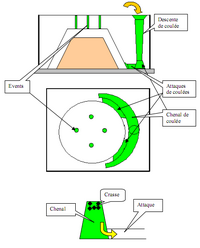
For the molding of kitchen utensils such as pots, in a general external form as cylindrical or conical-trunk form, a mold can be achieved as described and illustrated below:
- Creation of a sand bed, plan of 3 to 4 cm thick on the ground of the workshop
- Dispersal of the interior of the model by talc or wood ash finely molded to allow the demolding
- Filling of the sand-pot model, clamping (settlement), to the brim with the rammer, obviously to reduce the load to handle.
- Laying of this latter on the bed, with the edge facing downwards,
- Laying down the descent model and the channel model
- Installation of frame
- Filling of the frame with sand,
- Compaction, and tightening by the rammer, and then with the foot
- Whole of the funnel and attacks in the sand, the attacks and the channel can be made with a model as well
- Demoulding of the attacks and the model
- Lisser of sand and breaking of the edges
- Perforating of events <<pencils>>.

Filling the hollow part of the pot with sand. Clamping and releasing the whole together.

Production of a sand bed of 3 to 4 cm in thickness and with top surface facing the frame.This sand bed will therefore act as bottom of the mold.

Setting up of the pot on the sandbed and a wooden frame.

Positioning of a tube of wood that will serve as a model for the descent.
The sand must be well clamped at the base to keep the timber in position. Filling of the mold with sand.

We measure the funnel that requires to have one side to the right (see diagram left - topview of the funnel) to avoid creating a vortex that pulls in air and dirt to the imprint.
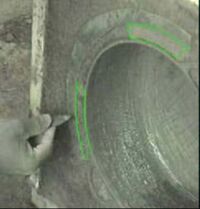
We measure the attacks

Demoulding of the channel that could be made either out of the upper mold (left) or in the lower part (right)
Molding by source casting with two frames.
Casting of a skillet
This is the most common encountered method in the northern countries. For cooking equipment, it can be performed not on the ground, but on a workbench. This technique can be used to cast a french skillet shape of the brand "Tefal" with a slope at the panhandle. Note; In a large production, it is clear that there should be a quantity of molds for the amount of melting capacity of the melting pot or duration of the working day ...
Fusion
Furnace
Characteristics of the types
In a simple form, the furnace can be a cylindrical hole dug in the ground, where the vertical wall is lined with cemented bricks. A refractory cement allows a longer lifetime.
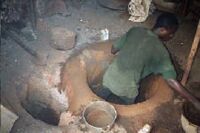
In the bottom of the holes, we find a full cylinder on which a melting pot is placed which allows a better exposure of the melting pot to the flames, the "cheese" of which the diameter must match that of the base of the melting pot.
Air inlet Cheese melting pot
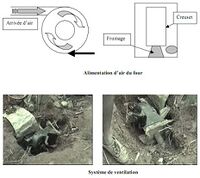
The diameter of the furnace depends on:
- The capacity of the melting pot, its diameter, and;
- The average size of the charcoal pieces.
The dimensions of the furnace made in Yaounde, on the occasion of the intervention of ISF in October 2004 are: Ø: 500 Depth: 700 mm Height of the cheese: 180 mm. It was intended to receive a melting pot with a capacity of 60 kg of aluminium. A fan-recovery turbine sends the air necessary for combustion into piping leading into the lower cylindrical furnace. Quite often, the air intake with the combustion gases such as those of coal, coke and charcoal is made at the bottom of the oven, which was not included here. If the air is introduced a bit higher, tangentially to the wall of the furnace -which somewhat simplifies the design of the furnace- we can multiply the supply of air to activate combustion. If we adopt more, we must ensure that they do not interact. It will thus be limited to two entrances, the design which also allows modules and easy adjustment of a heater. Between the melting pot and the wall of the kiln, we must leave a minimum space equivalent to 2 times the size of the largest pieces of charcoal, to facilitate the descent of the latter during combustion. A minimum of 10 mm indicates itself on the other hand, taking into accountthe expansion of the melting pot.
Having 2 or 3 furnaces of different sizes can tailor the amount of molten metal to the importance of contracts in progress and possibly avoid an accidental breaking of a melting pot. A second hole is generally foreseen, dug deeper and near the first to collect the metal of the melting pot in the event of a accidental breaking. The two wells are connected in their heart by a sloping fairway. A steel rod is placed permanently.
During the breaking, the metal flows into the second well. The bar allows to extract the metal after solidification. Another type of standard furnace of 200l. seen in Douala in particular and also used in Peru, is made up of a typical oilbarrel put on the floor, covered with a layer of poteyé bricks. The poteyage can be done:
- either by a mixture of clay, silica sand, respective volumes of 1/3 and 2/3, and crottin (or ashes of rice husks, or diatomite)
- or by clay, silica sand, ash of rice husks and jasmine.
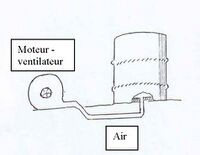
This type of furnace resists 2/3 heaters. While casting, access to the molten aluminum will be less easy. Can be used for conventional ventilation, an engine salvaged from a washing machine. In the event of failure, it is advisable to provide a training manual for the fan: a bicycle wheel, pedals and demultiplication, as seen in Douala.
The operation of the furnace
While conducting the merger, you should pay attention mainly to two things:
- The formation of dross, metal oxides, blown by the wind,
- The porosity of solid metal that may occur by absorption of fusion gases.
The second phenomenon has been seen as a less critical factor in the foundry of Yaoundé which was assisted by ISF. To limit the formation of oxides, we may spread in the bath area a thin layer of sand or, preferably charcoal. It is also important to dry the tools that will be in contact with the liquid metal.
Precautions
At the commissioning of the furnace: a furnace unused for several months demands drying before bringing it to to a red and then dark red color (750°C). The moisture in the coating of the furnace requires some experience to the operation. Experience such as the craftsmen have is good, it is good to consult them because of the danger of explosion that can occur when it is heated too fast. A manufactured furnace requires a drying in the open air, followed by entry into service in two stages: elimination of moisture in the form of visible water vapor, and then cooking. At the level of furnace operation, you should
- Merge as soon as possible to avoid a maximum of dross.
- Avoid the insertion of cold chips which form large quantities of dross (oxides)
- Pack charcoal to avoid pulling too high.
- Load aluminum alloy very often, the heaviest ones first, profiles afterwards, and finally electric cables.
The first have usually a lower melting point, and for a bath to receive the second ones.
Findings of the temperature of molten metal
Without knowledge of the composition of molten metal and without measuring instrument, it is difficult to assess the ideal pouring temperature. Especially since this composition can vary depending on the type of scrap melted. Ideally, during the casting, the molten metal will be in the range of precise temperatures and therefore must be able to meet the following three questions:
- Is the temperature high enough?
- Is the temperature not too high?
- Does it contain gaseous inclusions?
Three small assessment tests are sometimes used to estimate the temperature of casting:
- dark red:
- Hardening of a steel wire, kind of concrete iron in the mixture. If during the removal, the aluminum does not stick, the pouring temperature is reached.
- testing the presence of gas in the metal, despite a degassing:
- take a sample of metal in a small dish of a slight tronconical form, with dimensions Ø 45, Ø 40, H 35 mm;
- In the case of bubbling during solidification and a upper surface which is curved upwards without retassure, there is presence of gas in the melted metal.
- detecting a too high temperature causes expelling of gas from the metal:
- On a preheated stone, sink a little metal
- In the case of bubbles while the temperature is near or above 800° C, there is escaping gas.
These latter two tests are useful only if they are carried out together with a degassing operation, described in the appendix. It is only useful in cases where one wishes to obtain an upper surface of high quality.
melting pot
Poteyage For non-critical quality parts, as kitchen equipment, all types of cylindrical steel containers can be used, provided it is poteyé, by a layer of clay or refractory cement.
Pottery formula with clay: 2 parts of dry silica sand, 1 part clay refractory, as clear as possible.
After mixing, add water to get the same consistency as that of a painting. Before use, poteyage must be very carefully dried for 2 to 3 days. The poteyage is carefully mixed and expanded to ensure that no air pockets are are formed. The melting pot is dried at low heat during the first 2 to 3 hours, the time required to evacuate water vapor and then heated until red and then quickly to bright red. It is cooled slowly, all holes plugged. If it has been stored for a number of days at the beginning of the heating of the furnace, it is important to moderate the pace of firing, for its drying. Dimensions The choice of the appropriate size of the melting pot depends on a set of elements. It primarily depends on:
- Availability of raw materials, scrap, and quality
- The area available for the disposal of molds
- Availability of labor force, usually of independant status
- The energy consumption.
This choice therefore influences thus the working capital. We will therefore foresee melting pots and furnaces of different sizes, as illustrated in a schematic above on the schematic of the workshop. Melting pots of a capacity of 600 kg of molten metal were seen in Yaounde: made of a section of cast iron water pipe, to which a foundation has been welded. This particular important dimension was justified by the desire to limit the time of rental of the workshop and also to meet large orders. However, this presents a risk of some loss of metal in case of production incidents such, perforation of the melting pot, inadequate composition of the molten metal. It also requires solid means of handling, a hoist ... This is why melting pots of such capacity are quite rare.
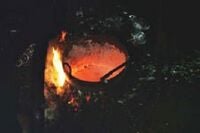
Small melting pots are often operated by only one person. In the business, we also find melting pots of standard sizes made of graphite, silicon carbide ... unfortunately at a very high cost. These are imported products.
Commissioning of the furnace/Precautions The local artisans can usually easily inform themselves about the precautions to take in regards to the heater in order to avoid accidental or premature degradation.
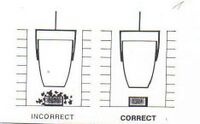
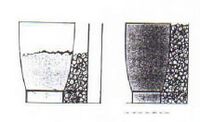
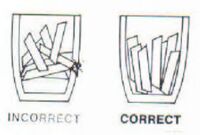
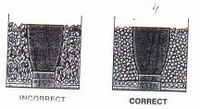
Precautions to be taken before use
- No fuel between cheese and melting pot
- Level of leveled charcoal coming over the top of the crueset to have a uniform heating and to avoid any horizontal rupture of the melting pot.
- Loading of waste long, vertically
- melting pot not too low in the furnace for fear of causing a slit in the lower tiers
- An average size of charcoal also prevents too intense and localized flames that lick the surface off the melting pot and provoke rupture.
- The level of molten metal near the top of the melting pot.
Casting

Before starting on this operation, we must take care to slowly stir the liquid with a corny (steel rod) poteyé so to stir up the surface oxides possibly in suspension and then skim the "filth" floating untop of the surface of the bath, using a skimmer. The casting will often pick the ladle of molten Al, directly into the melting pot. If maneuvers are being simplified, one can proceed in two stages and use a pocket from which then flows on the molten metal, in series.
The feeding of the liquid into the molds must be done while avoiding turbulence which can promote contact between air/metal and therefore the formation of alumina and without interrupting the stream of casting, which should get the funnel full. Eventually, when the casting is complete, a thin layer of magnesia is sprinkled on the mass. By reaction with aluminum, it maintains for a certain time the level of temperature of liquid (or already paste) aluminum.
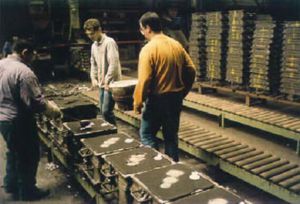
Materials poteyées ladles: already mentioned in other paragraphs Skimmer Pockets: see above Stretchers: To enable the handling of ladles, handling them is done using stretchers made by two operators of which one provides the rotation the pocket casting of Al into the funnel of each mold. Magnesia powder: reaction magnesite + aluminum releases heat in the mass, and keeps it liquid longer.
Precaution All utensils coming in contact with the molten metal must be carefully poteyés to avoid risk of explosion.
Cleaning the melting pot At the end of casting, a residue of molten metal and slag remains in the melting pot,these come from dirt, supernatant. They must be removed before the next cast.
Finish
Is done by the following steps:
- Demoulding ie, removal of the casting <<décochage>>.
- Light cleaning with a brush to remove any sand adhering to the workpiece
- Cutting and mass of the casting jes by shears, by means of a saw or disc
- Light sanding outside and inside the room by abrasive sander belt
- Polishing the drum of the pan set in a chuck, if necessary.
This polishing operation is significantly less than that currently done on traditional pots made in Cameroon today.
Materials

The following equipment may be justified
- A band saw (blade without end), to remove the weights and possible casting jets, commonly used in joineries as foundries, ...
- Blades for Aluminum to lubricate for thicknesses > 4mm
- A abrasive endless sander belt, commonly used in carpentry
- A "disqueuse".
- A lathe with a chuck claw keeping objects in cylindrical symmetry, which can come either from an old tower or metal timber equipped with an electric motor, or a potter's wheel, or a transformed remoulding machine, equipped or not an electric motor. Means also polishing procedure. Use with paper or abrasive canvas with manual maintenance rubbing against the object by polishing in cylindrical symmetry of rotation. Vitesse: ~ 300/400 rpm, for the abrasive canvas. The paper is kept in contact with the pot by polishing by hand.
- A system of dust suction, or masks to protect against dust, they are however unpleasant to use with the high temperatures.
- The use of abrasive belts for the surface sanding may have the disadvantage of showing inclusions and pores that would still be present under the skin of the same part.
Small tools
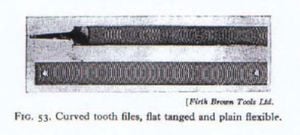
- Hacksaw for aluminum
- Toothed limes scaled for radial parallel, for non-ferrous metals
- Corundum abrasive paper, delivered in the form of tape, the grain 80 gives an excellent result, tested on traditionally manufactured pots.
Sources of Energy
We distinguish the main operation here by the obtaining of the molded object, auxiliary finishing operations, and polishing.
Main Operation
Charcoal, coal, gas and fuel oil has been used for these production processes. In sub-Saharan Africa there is a tendency to use the first, as it is a traditional fuel. This is also the fuel used by our by our Cameroonian partner. And for now, it can be justified for the following reasons:
- Known fuelsource in these regions, generally adopted for home use, so technically easy to use for all
- Regularity of supply independant of constraints such as power outages, which may be frequent, and which have the effect of interrupting the process of merging
- Technically, it does not require delicat maintenance equipment reserved for a specialized workforce
- Reduced installation costs
- Pollution caused by its employment, is reduced
- Availability and cost on the market are often better than that for coal and gas ..
Regulating the temperature of the process is more difficult to achieve. That is one reason why gas and liquid fuels are often more expensive to buy in Africa, they are preferred in processes of industrial facilities.
Ancillary operations
Only the furnace fans, the finishing machines and lighting of the premises require a electricity grid. A network of ~ 220V, 35 or 60 should suffice.
Characteristics of the raw materials
Metal
This is waste of variety of objects. It is therefore difficult to characterize them chemically with precision. In addition to aluminum, they also contain other elements, metallic or other. However, we can distinguish the waste which are likely to contain alloy elements. These are generally heavy, with a specific high density: engine parts of vehicles, such as housings.
Sand
The supply of sand should not pose a big problem in sub-Saharan Africa. A sand which any potter can acquire is appropriate. A test such as the one suggested here can already give strong indications about its essential qualities:
- Permeability to gas at the casting
- Cohesion, so as to avoid that grains may detach during the casting
- Easily deformable, plastic when aluminum is contracted on cooling.
For the measurement of moisture content, a not too expensive measuring device with calcium carbide may be used, the procedure is described as well in paragraph 4.2.1
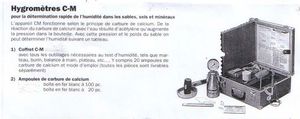
The moisture content is adjusted prior to molding; it may be more effectively evaluated prior to molding by taking a handful of sand that is ready to use. When tightly pressed in the hand, the hand must open, clearly revealing the imprint of the fingers.
Small products
Talc and wood ash, finely ground can serve as an insulation bonding between the model and the <<à vert>> sand.
Water
It is only necessary to adjust the sand content in order to obtain a gas permeability, and plasticity.
Finishing
In their molded state according to the "source" technique, the pots must be deburred to the level of their outer edge. This deburring as well as a cutting of the casting drop, the channel and the attacks are sufficient. They do no longer require much more work polishing the outer surfaces or interior surfaces.
Tools
Hand tools:
- Teeth saw pointing forward in the path to follow
- Curved teeth lime for soft metals or preferably sand paper.
- Holding mandrel if the piece is a pot.
- A light sanding can make an extra shine, if this is necessary, both to the the outer surface as the interior.
- Rotary tool with abrasive corundum, grit 80, or paper of the same type.
- If the piece is a pot, it can be maintained while holding it with a turning point chuck claw. Claws grasping the edge of the pot. The paper is kept in contact with the surface of the pot by hand.
Machines
- 1 older head with metal tour, with a rotating speed of about 200 rpm and 1 kw power will suffice.
- 1 adapted teethed chuck claw
Profits
Only a selling price established under known conditions which are determined accurately can be taken into account. This is something which could not be achieved in the conditions observed in Cameroon in August 2003. The values in the table below are therefore subject to change. As a reference, the selling price of two cookers has been identified in the large area of Nikki to Mokolo-Yaoundé, in the same period. We may thus consider that with the suggested methods and procedures, the selling price should certainly not be higher than that of the Cameroonian producers. The quality of the piece obtained raw from the foundry is far superior to that of the products prepared artisanally and sold on the Cameroonian markets. The main gain is retrieved in the reduction of work in the finishing of the pieces.
Ø
Quantity of primary matter
Price of of primary matter
Worktime
Charcoal
Returns
Selling price of the artisan
Selling price in Nikki
cm kg FCFA FCFA FCFA FCFA FCFA 20 2 1000 350 300 1650 2000 30 4 2000 500 400 2900 3500 4750 32 5 2500 700 400 3600 4500 5100 37 7 3500 900 500 4900 6000
Staff Taking into account the observations made in Cameroon, it is estimated that, in Cameroon, a facility producing 400 kg of pots of Ø 300 per week would provide direct employment to 6 manual workers, full or part time. Cost of labor at 8/03: 3500 FCFA per day. Matter Cost of scrap at 8/03: 500 FCFA/kg
APPENDICES
Appendix 1: Machinery and Tools
Type of machine Quantity Features Current (A) Total cost € Band saw 1 220V 7 3000 Double ribbon sander 1 220V 0.750 350 Degassing tube 2 SiC 354 Vertical sieve 1 mesh 50 * 20 mm² 21.3 0.6*1m² Tools Casting sieve 2 100 Canvas for casting sieve 1 m² Bandage roll 1 Bandage glue 1 Saw blades 10 265 2 nitrogen bottles Nitrogen injection can 2 400 Device to measure humidity 1 923 Total 5413 Pricing as of 6/2004
Appendix 2: Degassing
For critical parts or to obtain a better surface appearance of the parts, it is necessary to degas the molten metal before pouring. Different techniques are used to this end, the most appropriate in the current context uses nitrogen gas.
Degassing with nitrogen gas At the end of the merger, the heating of the melting pot is stopped or moderated by the decision of the ventilation of the furnace, which initiates the lifting of the dirt to the surface of the bath.
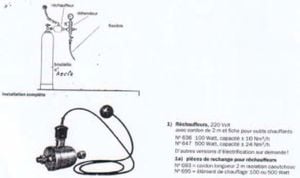
You may also proceed to immersion of pellets generating nitrogen at the end of the melting. Precautions to take: the gas and the pellets must be absolutely anhydrous.
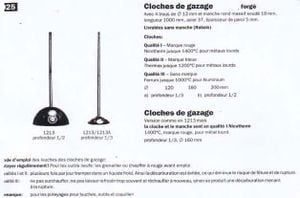
To limit the import of expensive consumption materials, the first solution is often preferable, even if the injection rods have a certain fragility. Duration: Allow 5'/100 kg of molten metal.
Controlling the degree of degassing The mixture which is melted and possibly ready to pour, is submitted to a precise checking of its temperature which has to be kept constant at ± 5° C. An efficient degassing can only take place if the melting pot is transferred to a separated furnace, heated by oil or gas.
Appendix 3: Sorting of scrap
The following elements may be used to determine the likely composition of the metal.
By appearance
Presence of rust: ferrous metal Gray look while oxidized: zinc Whitish appearance when oxidized: aluminum or magnesium Yellowish/reddish appearance: copper alloy
By its use
Boxes of light tools such as chain saws: aluminum alloy Sole of an iron: aluminum alloy Light kitchen utensils: aluminum alloy Profiles of window frames: aluminum alloy Car wheels and enjoliveurs: aluminum alloy High voltage electric cables: aluminum alloy Engine blocks and gear boxes of Volkswagen cars: magnesium alloy Car parts: pumps, electrical boxes cast under pressure: zinc alloy Engine pistons: aluminum alloy Non-magnetic electrical parts, shaft bearings, valve parts: cupper alloy Pieces of heavy machinery, engine blocks, agricultural machinery: ferrous metal Regular electrical wires: copper alloy Water pipes: steel or copper; distinction in appearance Springs, electrical contact parts, bearings for rotating shafts: copper alloy or tinned steel Gutters: zinc Battery plates, insulated electric cables: lead Carburetor of car engines, pumps, electrical boxes: zinc
Appendix 4: Traditional casting
Ground molding for drop casting by means of a single frame
This is the easiest method to make the mold. It is used especially in India, Egypt and sub-Saharan Africa (Cameroon, Benin, ...) but only gives a quality with poor surface finish. We prepare by making the ground surface flat, kind of a flange. The marmitemodel is filled with sand, well tamped with the rammer. It is made on top of it, with the opening downwards, we will have a part of the sand emptied in order to reduce the weight. Insulation such as talc or crushed wood ash is sprinkled on the mound which is also formed. A frame is placed around the pot as a model with sloping channel and a tube or a round brush, model for the flow channel. The molding sand is packed into the frame. We fix with some strokes the position of the frame relative to the sole. The frame, which accompanies the pot is unmoulded, the model is separated from the mold frame. Finally the frame is again placed on the sole and the sod takes care of the repérage. The process is illustrated in the appendix.
Particular uses:
- for simple pieces and pieces of large dimensions for which the time for solidification is limited, can this method be useful
- With a rehausse, or enlargement of the metal, the quality of the workpiece can be improved; it can remove the dross which is formed during the casting more effectively
- For certain pots, of hemispherical shape, the mold can be achieved in two or three pieces to avoid the handling charges of becoming too heavy.
- The quality, and appearance of the surface will be less good, but the pencil events are locatable, if necessary, for the evacuation of the gas flow.
Sketch of a traditional Cameroonian mold for a pot of Ø 30 cm
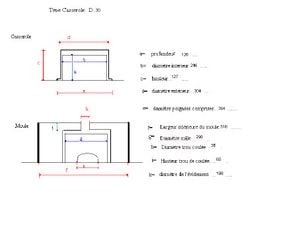
Appendix 5: Creation of a clay/graphite melting pot
The literature on the subject often suggests ancient formulas for this fabrication, which sometimes seems anecdotal on one side, but effective, using a mixture of sand, clay, graphite, bran, and cow dung.
Appendix 6: Color of metal depending on temperature
Color Temperature barely visible 630° C Visible 675° C Dull red, dull 775° C Dark red 850° C Bright red 990° C
Appendix 7: Test of source casting of a skillet
The casting test was carried out on a skillet of the model Tefal1 by means of two frames.
Mold for the skillet Figure 37 represents an unfinished molded pan from Yaounde and the replica of this was made in Belgium and and its description is given above as well as the used mold. Description of the test: source casting of a skillet of this type. Sheet of the test: Item: skillet Dimensions: Ø exterior 260 mm H 20mm handle Al + plastic L, 170 mm, slightly inclined l, 25 mm riveted base thickness 3.5 mm slightly sloping lateral sides, height: ~20 mm Model: skilet of Tefal/Armatal brand
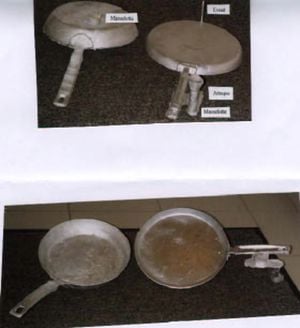
Purpose of the test: source casting of a skillet of this type Alloy: ASG3 Sand: chemical granulometry ~ 95 AFS Workshop: Divry-Bertrand Date: Week of 7 June 2004 Mold: 2 frames
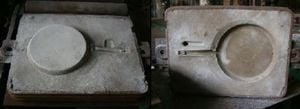
Steel frame: 500*400, H 225 mm Source casting, slightly leaning, handle side Casting hole: Ø 20
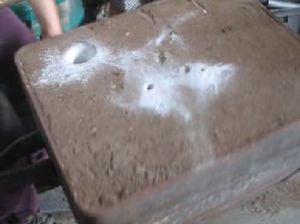
Casting slope 60, mounted on a tronconical funnel: H25 Ø 34 Fed by handle
Flow channels: half-cylinder Ø 18, L 65 Attack of channel at a right angle to the handle, length 16 connected to the handle on a width located 50 to 90 from the end of the handle. Event: on the opposite side of the handle, Ø 5 L 70 Vent smooth surface on top of 18 Surface ext. and bright interior
Appendix 8: Diversification of the products
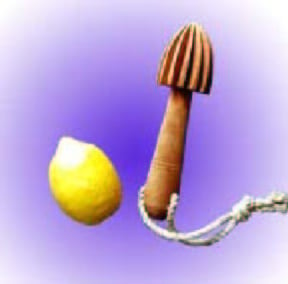
This current file was focused mainly on the manufacturing of kitchen utensils for pots. The suggested techniques can be used for much more products, such as for:
- Mechanical parts: pulleys, wheel discs (see cover photo)
- Medals, identification tags and other decorative objects
- More special kitchen utensils, such as ladles, pots on 4 feet, such as the ones used in Egypt, or ladles (see cover photo). With a little ingenuity or artfulness, it is possible to achieve:
- A round-walled pot as in Benin (see cover photo on the far right), which requires a mold in several pieces
- A manual citrus press which is more common in Asia, see for example, the model shown in this document and we have also seen a copy casted in Al.
- Alters to exercise the muscles of the hand with springs, the latter offcourse in steel mountable afterwards.
- Spoked wheels for trucks (see Figure 1).
- sheaves
Appendix 9: References
- Irmann (R.)La Fonderie d’Aluminium en Sable et en Coquille, trad.Moiroud (J.), Paris, Dunod, 321 p.
- Le Breton (H), 1955, Pour le Fondeur d’Alliages légers, Paris, Dunod, 248 p.
- Nicolet (A) et all, 1954, Le Modeleur-Mécanicien, Paris, Eyrolles, 360 p.
- Fabart (A E), 1926, Manuel du Fondeur, Paris, Librairie J.B. Baillère et Fils, 416 p.
- Laurat (Ph) , 2001,Mise au point d’une gamme de foyers améliorés et réchauds et préparation de la diffusion, Ndjamena, AEDE, 35 p.
- Goovaerts (L) et all, 2001,Beste beschikbare technieken voor de Gieterijen, Gent, Academia Press, 328 p.
- Fonderie G.Fallais, 2003, divers documents commerciaux et techniques reçus en consultation, Villers-Le-Bouillet
- Hitchings (R), 1985, How to make cutting-shears for sheet metal, London,Intermediate Technology Publications, 22 p.
- Dudouet (M),1980, Fonderie Memento de Technologie de Moulage- en Moules non-permanents, Paris, Syndicat général des Fondeurs de France, 90 p.
- Sandam (R)et all, 1967, Metalwork, London, Edward Arnold, 256 p.
- Documents du Centre Technique des Industries de la Fonderie (CTIF), France.
- Documents commerciaux des sociétés M.C.Technics, Sival, Deby, Bouvier Technofour, etc.
- Le Breton (H.),1955, Pour le Fondeur dAlliages légers, Paris, Dunod, 248 p.
- Nicolet (A. et R)., Brodbeck (G.),1954, Le Modeleur-Mécanicien, Paris, Eyrolles, 360 p.
- De Smet (G.),1972, La Pratique des Traitements themiques des Métaux industriels, Paris,
Dunod, 529 p.
- Dennis ( W.H.), 1963 2d 2e éd., Metallurgy of the non-ferrous Metals, London, Pitman, 790p.
- Razous (P.), 1949 5e éd., Théorie et Pratique du Séchage industriel, Paris, Dunod, 259 p.
- Hirst (S.), repr. 2002 , Metal Casting Appropriate Technology in the small Foundry, London, ITDG Publishing , 227 p.
- Feinberg (W.), repr. 2002, Lost Wax Casting A Practitioners Manual, London, ITDG Publishing, 74 p.
- Gingery ( D.J.), rev. 2002, The Charcoal Foundry, Rogersville (MO.USA),David J.Gingery Publising L.L.C.-
- Cosack+Co, Taco Crucible Service, Neheim-Hüsten 1 (RFA)
- Chastain (S.), 2002, Oil-Fired tilting Furnace, Jacksonville (FL.USA), 192 p.
- Navy Department-Bureau of Ships, United States Foundry Manual, 1944 repr. 1957, Lindsay Publications Inc., 291 p.
- International Correspondence Schools, 1906, repr.1983, Secrets of Green-Sand Casting, Lindsay Publications Inc., Bradley( IL.USA), 167 p.
- Harper (J.D.), 1981, Small Scale Foundries for Developing Countries, ITDG,London.
- Gingery (V.), 1986, Making Crucibles, Paperback David J.Gingery Publishing.
- Relf (C.), Scrap Metal Recovery, An Experience of intermediate Technology in Papua New Guinea, IT Publications
- ?, ?, Aluminium Kookpotten, Atol, 5 p.
- Defrancq (Ch.), 2005,Les Défauts de Fonderie générés par le Sable,Origines et Remèdes, Groupe de Travail Wallonie-Bruxelles, Seraing, Edition Enseignement Supérieur-Perspectives nouvelles, 14 p.47
- Dejonghe (M.), 2005, Les Défauts de Fonderie générés par le Sable,Expériences pratiques, Groupe de Travail Wallonie-Bruxelles, Seraing, Edition Enseignement Supérieur-Perspectives nouvelles, 11 p.
- Marchioni(B.), 2005, Les Défauts de Fonderie générés par le Sable, Expériences pratiques, Groupe de Travail Wallonie-Bruxelles, Seraing, Edition Enseignement Supérieur-Perspectives nouvelles, 38 p.
- Bellanger (G.), 2005,Conception et Tracé des Pièces de Fonderie en Fonte et en Acier, Seraing, Edition Enseignement Supérieur-Perspectives nouvelles, 55p.
- And many other documents found on the Web